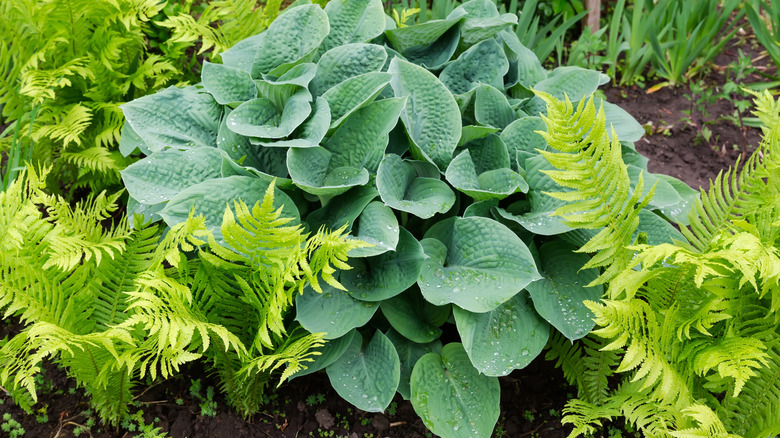The Flowering Ground Cover That Pairs Beautifully With Ferns & Hostas
It's easy to see why ferns and hostas are staples in many American gardens. They're generally easy to care for, and they're perfect for adding more texture to nearly any space. Because both plants are known for their foliage, adding a flowering ground cover can spice up a garden bed with a bit more color. In addition to being pretty and bright, ground covers help to choke out unwanted weeds by outcompeting them for light and nutrients. They're also the go-to plant to help control erosion on slopes and grow in areas where grass or other species struggle to survive. Not all ground covers are compatible with everything you grow, especially in shady spots. Which is best for growing alongside your sun-adverse ferns and hostas? Why the dainty violet, of course.
A foliage-heavy shade garden is pretty in its own right, but a pop of color can take it to the next level. Violet (Viola spp.) is a genus of perennial and annual plants with attractive heart-shaped or elongated leaves. These low-growing plants boast flowers in a variety of colors, which will allow your hostas and ferns to shine without overwhelming the area with even more green. Violets have similar sunlight and soil preferences as hostas and ferns, making it easy to grow a gorgeous, healthy shade garden. That said, although this ground cover thrives in moist, dappled shade, it can grow in all light levels. Most violet species and cultivars aren't too picky about soil either — native violets will even tolerate clay. This diverse genus has plants for gardeners spanning Zones 1 to 10.
Consider common blue violet as a partner for ferns and hostas
The common blue violet (Viola sororia) is a good choice from among this diverse genus. It's a U.S. native plant that, in the wild, grows along shaded stream banks and woodland edges. Gorgeous pink, blue, purple, or white flowers first appear in spring, bringing pollinators into your yard and garden, like bees, moths, and butterflies — particularly the fritillary butterfly, which lays its eggs on the plant. By summer, the flowers are replaced by jaw-like seed pods, which are attractive to birds and small mammals when ripe. Deer don't care much for this sweet flowering ground cover, though rabbits may snack on the leaves. This violet is a Zone 3 to 7 plant, which matches hostas' Zones 3 to 8 and ferns' Zones 4 to 10, though the foliage may start to die back in hot summer weather.
Like many ground covers, common blue violet self-seeds and is rhizomatous. As long as conditions remain ideal, it will spread freely under- and over-ground with little intervention from the gardener. In fact, the plant can be so successful that it can become aggressive if left to its own devices. Mowing excess growth is an effective control. Common blue violet easily outcompetes weeds, but that also means it can steal nutrients from turfgrass and nearby plants. If you're concerned about the health of your hostas and ferns, periodically thin out any extra growth by hand-pulling over-zealous violets. That way, they won't be competing for the same resources. If your fern, hosta, and violet-filled garden bed borders your lawn, install a physical barrier, like garden edging, to stop violets from creeping into it.

